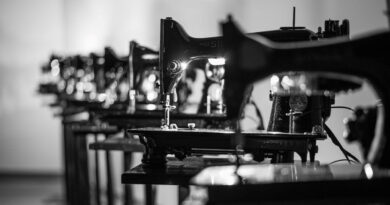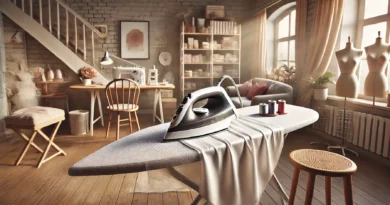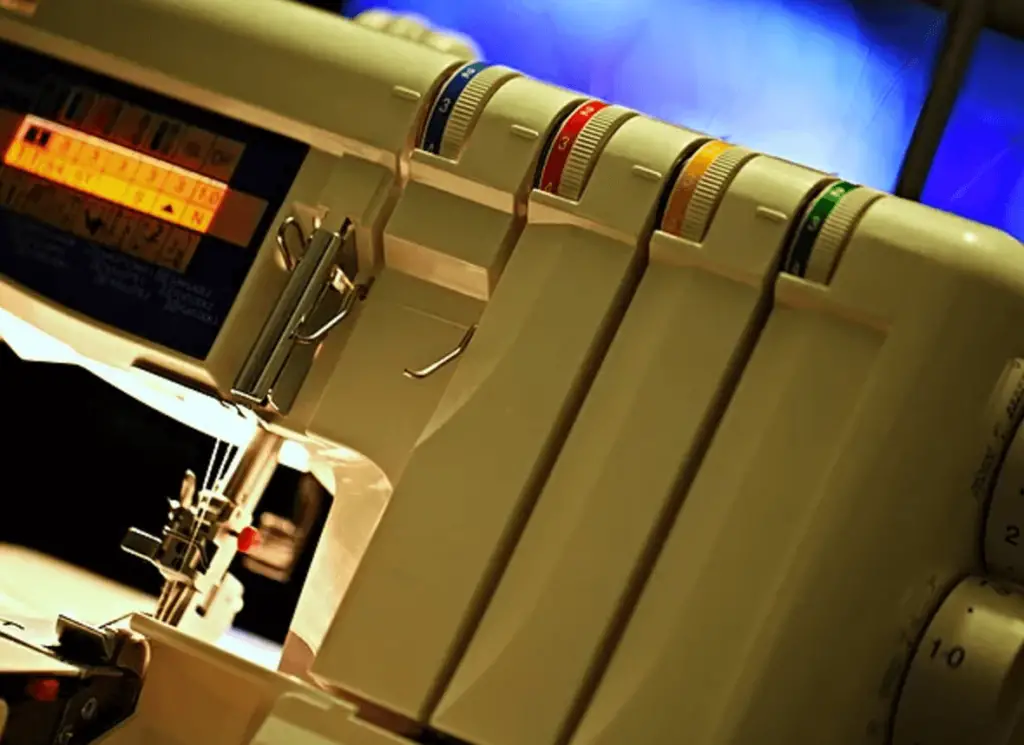
Should you go for a serger?
Many of us wonder what a serger is. Is it a necessary and useful investment in addition to the sewing machine? What can it do? And what are the most important points to consider before investing in this new device?
What’s the difference with a sewing machine?
The main differences between a sewing machine and a serger are the multiple possibilities offered by a serger. This machine takes you into a more professional world, with finishes for your children’s garments that rival those sold in stores. That is, once you’ve tamed the beast! Because a serger is a war machine! It’s a lot more nervous than a simple sewing machine, and a lot more dangerous!
A serger cuts / serges / assembles, all in one pass! In other words, if you leave your fingers lying around, it’s critical! Technicalities aside, a serger is essential for sewing elastic materials. Jersey, minky, fleece or sweatshirt, for example! The serger devours them without a second thought.
The serger has two needles, and can accommodate four thread cones (some machines have up to eight, but I’m only going to talk about the most common models here!) These two needles can be used together or separately. There are also two loopers that make the loops (admit it, the name is apt!).
If you’ve ever tried to sew a small tee-shirt, for example, you’ll know how tricky jersey is to assemble: the fabric slips, you have to pin every couple of centimetres, use a special machine stitch to make the seam hold… In short, it’s particularly stressful and complicated. But with a serger, once you’ve made the adjustments, all the sewing is done in one go! It’s amazing!
Overlocker highlights
- Home-made” is a double-edged sword: when it comes to cooking, it’s good. But when it comes to sewing, it’s rarely positive! By using a serger, you’ll be bluffing your world. The finish of a garment made with a serger is of professional quality, and the seams hold better over time.
- Sewing stretchy fabrics is a thing of the past. No more fabric stretching or fraying. The overlocker solves this problem once and for all, thanks to a “differential” that feeds the fabric at the right speed.
- If you’re a fan of overlocking, you’re in for a real treat! No more zig-zag stitching at the edge of the fabric with your sewing machine! The serger does it in 2, 3 moves without a hitch.
- You gain in speed of execution, and you gain in self-confidence! While mastering the serger can be a bit tricky when you’re just starting out, once you’ve mastered it, you’ll make a lot of progress! The sewing machine will seem so easy to handle afterwards!
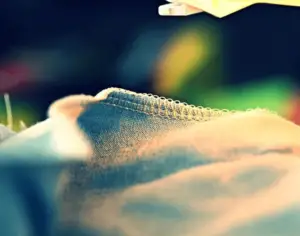
Weak points of the serger
- The big drawback of a serger is threading. If you found your sewing machine complicated to thread, you’ll soon find it easy once you’ve discovered the ordeal of the serger! However, depending on your budget, there are machines on the market whose threading is automatic thanks to a pulsed air system. This is extremely practical, as it means you don’t have to get your fingers into every nook and cranny of your new machine… But it’s expensive! Let’s just say that this feature is not yet available on entry-level or mid-range models…
- The second source of irritation is setting the voltages. For each of the four threads, you’ll need to adjust the tension so that the serger makes a beautiful stitch. Some top-of-the-range machines do this automatically. But most of the time, you’ll have to try different combinations before you get a nice stitch. It can be stressful!
- Mistakes are fatal! If you’re panic-stricken about your seam ripper, then you’d better keep your fingers crossed that you don’t make a mistake with your serger! Undoing a seam made with this machine will require you to spend many long minutes undoing it… If you can! Because the problem with a serger that cuts/surfaces/assembles is that it will be impossible to go back if your creation is too tight… You won’t be able to “glue” the fabric back together to start again!
- This machine is thread-hungry! Like a glutton! Most of the time, you’ll be using your serger with its four threads. So you’ll need four thread cones to sew. If you ever wondered why serger cones are so much bigger than the 100m spools on sewing machines, you’ll soon find out! In fact, if you’re looking for some, I recommend these!
Overlock sewing stitches
There are 4 main stitches:
- The 4-thread overlock stitch: this is the main stitch on the overlock machine. It is used to join fabrics, while overlocking the edges.
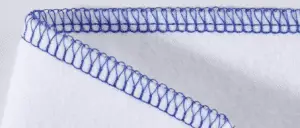
- The 3-thread overlock stitch: this stitch is used to overlock one piece of fabric, without joining it to another (except for certain very soft fabrics). It’s useful if you’re assembling your fabric later on the sewing machine. This stitch uses both loopers and one of the two needles. The right needle for a fine stitch, the left for a wider one.
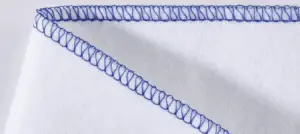
- Flatlock: this is a decorative stitch. The aim is to create a flat seam that shows clearly on the fabric. The stitch is made with 2 or 3 threads, in one or two loopers + a needle. Flatlock is sewn like an overlock, then the seam is gently opened to reveal the threads.
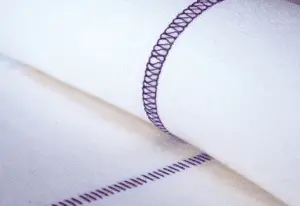
- The roulotté stitch: a decorative overlock stitch that creates a narrow hem on thin or fraying fabrics. The machine does it all in one pass! Unlike conventional hems, you don’t have to fold and iron your fabric before sewing – the serger takes care of that! Depending on the machine, this stitch can be done with 2 or 3 threads.
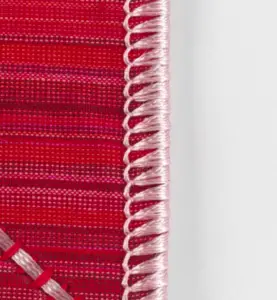
What to look for when buying a serger?
Before you break open your Livret A and get out your checkbook, there are a few things you need to pay attention to:
- First, choose a machine that offers 2, 3 or 4-thread stitches. These are generally a little more expensive, but so much more practical and versatile.
- Next, make sure the knife is retractable or deactivatable. This is useful for certain stitches or techniques.
- Ideally, your serger should be equipped with a waste collection tray. If you’ve fallen for a model that doesn’t have one, too bad. But if you haven’t made up your mind yet, check out this option, which will save you the hassle of vacuuming after every sewing session! Because sergers produce a lot of waste!
- Check that the machine has a “differential”! What’s a differential? It’s a function that allows you to vary the speed of the feed dogs. This allows you to obtain gathers, and/or to stretch elastic materials so that they are well sewn. In short, it’s important!
- Don’t look for a second-hand machine… What I’m saying here goes against my values, but as with buying a sewing machine, I advise against buying a second-hand serger. If you’ve never touched one, you won’t be able to test it properly, and you run the risk of getting a faulty machine. Of course, you may come across a superb second-hand machine. But do you want to play Russian roulette?
What a serger can’t do
A serger doesn’t do everything. It may be practical and multifunctional, but it doesn’t make coffee – and that’s its main flaw, in my opinion!
More seriously, a serger will never replace your sewing machine! You can reassure your sewing machine that it won’t end up in the garbage because you’ve decided to invest in a serger. It’s important to understand that these two machines are complementary. The sewing machine will do you a world of good when it comes to topstitching, sewing buttonholes or assembling lined garments.
The serger will ensure clean seams and finishes in a jiffy. It’s a real time-saver on stretch fabrics.
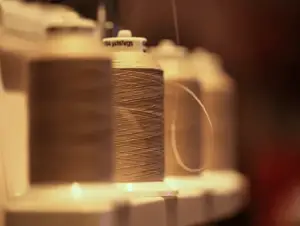
How much does it cost?
Buying a serger requires a financial effort. Prices range from 150€ to over 1000€… And the more money you put into it, the better the machine will be. In the end, it’s quite simple!
In my case, I wanted a model that was fairly complete and easy to handle, but without breaking the bank. After a lot of searching and comparing, I settled on the ELNA 664 Pro. This is a brand I didn’t know at all before discovering their sergers, and it has an excellent reputation! It’s a Swiss brand, and the prices are right on the money.
The Brother brand also has a good reputation, with generally more competitive prices. The Brother Overlock M1034D enjoys a good reputation and is a favorite with many users. And it’s half the price of the Elna serger.
A third brand stands out: Babylock! This is a top-of-the-range serger! Automatic threading, automatic tensioning, speed, sturdiness. A must-have, but (inevitably) expensive!
In conclusion, please understand that a serger complements a sewing machine. It doesn’t replace it in any way, but enables you to sew garments quickly and cleanly, with professional finishes.
It’s a worthwhile investment if you regularly sew stretch fabrics, or if you want to make garments with finishes that will wow everyone. The serger lets you do just that. It’s not an essential expense, but once you start using this machine, you won’t be able to do without it.

